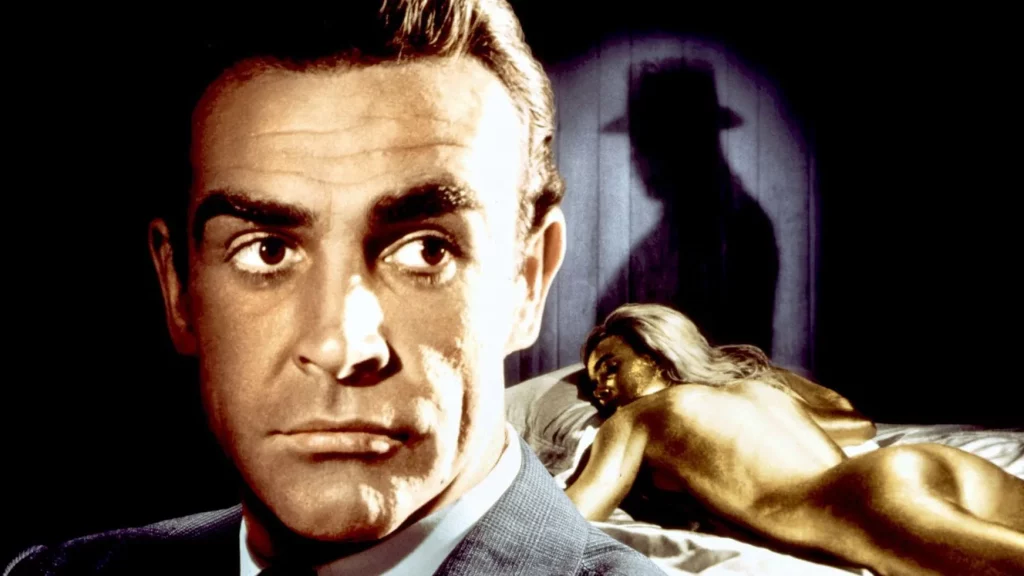Laura Mulvey discussed two aspects of male fixation in her 1975 book Visual Pleasure and Narrative Cinema.

First, the narrative structure itself contains the male perspective to shoot its guidance and express the male desire to watch movies. The second is cutting the female body according to the use of spectacle. For example, using close-up shots to highlight and enlarge the female parts breaks the illusion of time and space depth to meet the voyeurism of the female form.
Both build and strengthen the duality of “seeing” and “being seen,” thus making men the main body of dominant viewing. Women play the role of being seen and then become the spectacle to be consumed and enjoyed, while men find self-recognition in the high ground of control.

For example, in Goldfinger, the third 007 film in the early series, the image of Pusey Gallore also conforms to this characteristic, and her role is more used to meet the visual expectations of male audiences. Her name, “Pussy”, is even sexually suggestive.
Second, as a female character, Pusey is more of a proof vehicle for Bond’s appeal than an independent narrative core. Although she is supposed to be the leader of a team of pilots, this professional attribute is not fully developed or explored in depth in the plot.
Thus, the male gaze in the film is mostly for the female characters to objectify and symbolise, focusing on the appearance and the role of characters in the film.

In addition, the film’s male dominance is also evident in its narrative structure, which highlights themes of male power and female obedience.
In “Goldfinger,” James Bond is not just the protagonist; he also wields power and makes key decisions. He utilizes his charm and authority to “conquer” Pussy Galore, persuading her to abandon her allegiance to the villain and join his side. This shift not only illustrates Bond’s control over women but also suggests that women often compromise in the face of male determination.
Furthermore, the romantic subplot between Bond and Pussy includes a highly controversial scene involving “forced kissing.” Although this moment may have been perceived as romantic at the time, from a modern perspective, it reinforces the image of male power in gazing at and controlling the female body.
Although Goldfinger is considered a classic, it has limitations in its portrayal of female characters from a modern perspective.
For instance, the female characters lack independence and fail to break away from their dependence on male characters. Additionally, gender relations are often depicted as a dynamic where male power physically and emotionally subjugates women.

The concept of the male gaze gained widespread acceptance primarily because the film production and consumption market in the 1960s was dominated by men. This narrative technique and style of cinematography catered to the preferences of the audience during that era and contributed to the global popularity of Bond’s character. However, over time, this approach has reinforced gender stereotypes, overlooked the needs of female audiences, and subtly promoted values associated with gender inequality.
Fortunately, in today’s era, more filmmakers are challenging traditional narrative models. For instance, films like *Wonder Woman* and *Black Widow* present women as more proactive and complex characters from a female perspective.
In summary, the rise and popularity of anti-“male-gaze” films represent not only an artistic expression of gender and power equality but also a cultural reflection of society’s growing pursuit of diversity, inclusiveness, fairness, and justice. Such films enrich the art of cinema, reflect an enhanced audience aesthetic and awareness, and promote change in mainstream culture.
REFERENCE:
Cudo, A., Kopiś, N., Francuz, P., Błachnio, A., Przepiórka, A. and Torój, M., 2019. The impact of Facebook use and Facebook intrusion on cognitive control: Effect in proactive and reactive control. Advances in Cognitive Psychology, 15(1), p.63.
Nitzan, J. and Bichler, S., 2009. Capital as power: A study of order and creorder. Routledge.


hiii, Yiting.
Your post focused on analysing ‘what the male gaze is’ and ‘how it shows in narratives’. Through your post, I can see you really did a lot of research because you used many examples to support your point of view. The male gaze really can indeed be expressed in many different areas, and i believe you chose to research its definition because it’s the basic thing people need to know, if they want to observe its diverse expressions. all in all, i like your post.
Hi Yiting, I really like your article.This article takes the classic film “The Golden Finger” as an example to deeply analyze the embodiment of the “male gaze” theory in film narrative and visual language. The article reveals gender inequality in traditional films by analyzing the objectification and symbolization of female characters, as well as the dominant position of men in power and emotional relationships. At the same time, the author also proposes the progress of modern film and television in challenging this traditional narrative mode, providing positive directions for gender equality and diverse expression. The overall argument is rigorous and persuasive, but the exploration of anti male gaze films can be further deepened to balance the contrast between tradition and modernity.
The analysis of Goldfinger effectively critiques its portrayal of female characters and the reinforcement of male dominance, shedding light on the problematic nature of the male gaze in classic cinema. It also highlights the positive shift in modern films like Wonder Woman and Black Widow, where female characters are portrayed as strong, independent, and multifaceted, reflecting changing societal values toward gender equality.